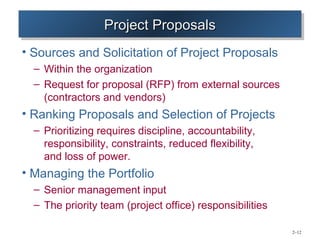Chap2
- 1. Chapter No.2 Chapter No.2 •Organization Strategy and Project Selection 2–1
- 2. Why Project Managers Need to Understand Why Project Managers Need to Understand the Strategic Management Process the Strategic Management Process • Changes in the organization’s mission and strategy – Project managers must respond to changes with appropriate decisions about future projects and adjustments to current projects. – Project managers who understand their organization’s strategy can become effective advocates of projects aligned with the firm’s mission. 2–2
- 3. Projects and Strategy Projects and Strategy • Mistakes caused by not understanding the role of projects in accomplishing strategy: – Focusing on problems or solutions with low strategic priority. – Focusing on the immediate customer rather than the whole market place and value chain. – Overemphasizing technology that results in projects that pursue exotic technology that does not fit the strategy or customer need – Trying to solve customer issues with a product or service rather than focusing on the 20% with 80% of the value (Pareto’s Law). – Engaging in a never-ending search for perfection only the project team really cares about. 2–3
- 4. The Strategic Management Process: The Strategic Management Process: An Overview An Overview • Strategic Management – Requires every project to be clearly linked to strategy. – Provides theme and focus of firm’s future direction. • Responding to changes in the external environment— environmental scanning • Allocating scarce resources of the firm to improve its competitive position—internal responses to new programs – Requires strong links among mission, goals, objectives, strategy, and implementation. 2–4
- 5. Project Portfolio Management Problems Project Portfolio Management Problems • The Implementation Gap – The lack of understanding and consensus on strategy among top management and middle-level (functional) managers who independently implement the strategy. • Organization Politics – Project selection is based on the persuasiveness and power of people advocating the projects. • Resource Conflicts and Multitasking – Multiproject environment creates interdependency relationships of shared resources which results in the starting, stopping, and restarting projects. 2–5
- 6. A Portfolio Management System A Portfolio Management System • Design of a project portfolio system: – Classification of a project – Selection criteria depending upon classification – Sources of proposals – Evaluating proposals – Managing the portfolio of projects. 2–6
- 7. A Portfolio Management System A Portfolio Management System • Selection Criteria – Financial: payback, net present value (NPV), internal rate of return (IRR) – Non-financial: projects of strategic importance to the firm. • Multi-Weighted Scoring Models – Use several weighted selection criteria to evaluate project proposals. 2–7
- 8. Financial Models Financial Models • The Payback Model – Measures the time the project will take to recover the project investment. – Uses more desirable shorter paybacks. – Emphasizes cash flows, a key factor in business. • Limitations of Payback: – Ignores the time value of money. – Assumes cash inflows for the investment period (and not beyond). – Does not consider profitability. 2–8
- 9. Nonfinancial Strategic Criteria Nonfinancial Strategic Criteria • To capture larger market share • To make it difficult for competitors to enter the market • To develop an enabler product, which by its introduction will increase sales in more profitable products • To develop core technology that will be used in next- generation products • To reduce dependency on unreliable suppliers • To prevent government intervention and regulation 2–9
- 10. Multi-Criteria Selection Models Multi-Criteria Selection Models • Checklist Model – Uses a list of questions to review potential projects and to determine their acceptance or rejection. – Fails to answer the relative importance or value of a potential project and doesn’t to allow for comparison with other potential projects. • Multi-Weighted Scoring Model – Uses several weighted qualitative and/or quantitative selection criteria to evaluate project proposals. – Allows for comparison of projects with other potential projects 2–10
- 11. Applying a Selection Model Applying a Selection Model • Project Classification – Deciding how well a strategic or operations project fits the organization’s strategy. • Selecting a Model – Applying a weighted scoring model to bring projects to closer with the organization’s strategic goals. • Reduces the number of wasteful projects • Helps identify proper goals for projects • Helps everyone involved understand how and why a project is selected 2–11
- 12. Project Proposals Project Proposals • Sources and Solicitation of Project Proposals – Within the organization – Request for proposal (RFP) from external sources (contractors and vendors) • Ranking Proposals and Selection of Projects – Prioritizing requires discipline, accountability, responsibility, constraints, reduced flexibility, and loss of power. • Managing the Portfolio – Senior management input – The priority team (project office) responsibilities 2–12
- 13. Managing the Portfolio Managing the Portfolio • Senior Management Input – Provide guidance in selecting criteria that are aligned with the organization’s goals – Decide how to balance available resources among current projects • The Priority Team Responsibilities – Publish the priority of every project – Ensure that the project selection process is open and free of power politics. – Reassess the organization’s goals and priorities – Evaluate the progress of current projects 2–13
- 14. Project Portfolio Matrix Dimensions Project Portfolio Matrix Dimensions • Bread-and-butter Projects – Involve evolutionary improvements to current products and services. • Pearls – Represent revolutionary commercial opportunities using proven technical advances. • Oysters – Involve technological breakthroughs with high commercial payoffs. • White Elephants – Showed promise at one time but are no longer viable. 2–14
- 15. Key Terms Key Terms Implementation gap Net present value Organizational politics Payback Priority system Priority team Project portfolio Project screening matrix Project sponsor Sacred cow Strategic management process 2–15















